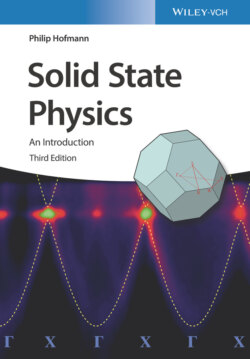Читать книгу Solid State Physics - Philip Hofmann - Страница 13
1 Crystal Structures
ОглавлениеOur general objective in this book is to understand the macroscopic properties of solids on a microscopic level. In view of the many particles in solids, coming up with any microscopic description appears to be a daunting task. It is clearly impossible to solve the equations of motion (classical or quantum‐mechanical) of the particles. Fortunately, it turns out that solids are often crystalline, with the atoms arranged on a regular lattice, and this symmetry permits us to solve microscopic models despite the vast number of particles involved. In a way, this situation is similar to atomic physics where the key to a quantum‐mechanical description is the spherical symmetry of the atom. We will often imagine a macroscopic solid as one single crystal, a perfect lattice of atoms without any defects whatsoever. While it may seem that such perfect crystals are not particularly relevant for real materials, this is in fact not the case. Many solids are actually composed of small crystalline grains. Such solids are called polycrystalline, in contrast to a macroscopic single crystal, but the number of atoms within a perfect crystalline environment in them is still very large compared to the number of atoms on the grain boundary. For instance, for a grain size on the order of atomic distances, only about 0.1% of all atoms are at the grain boundaries.
There are, however, also solids that are not crystalline. These are called amorphous. The amorphous state is characterized by the absence of any long‐range order. There may exist, however, a degree of short‐range order between the atoms.
This chapter is divided into three parts. In the first part, we define some basic mathematical concepts needed to describe crystals. We keep things simple and mostly use two‐dimensional examples to illustrate the ideas. In the second part, we discuss common crystal structures. For the moment, we will not ask why the atoms bind together in the way they do – this topic will be discussed in Chapter 2. Finally, we delve into a more detailed discussion of X‐ray diffraction, the experimental technique that can be used to determine the microscopic structure of crystals. X‐ray diffraction is used not only in solid state physics but also for a wide range of problems in nanotechnology and structural biology.
